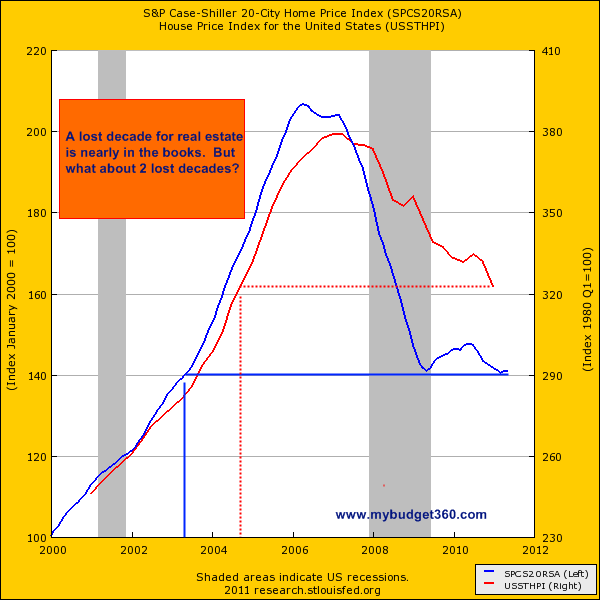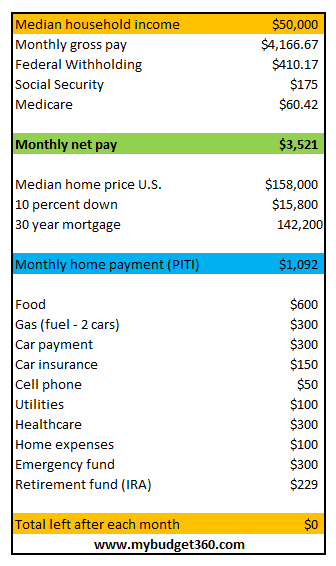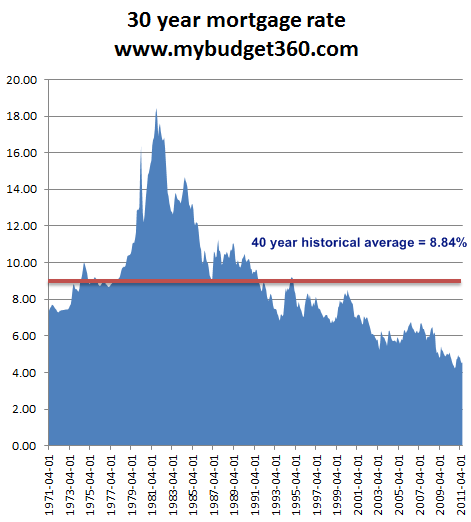The 20 year financial depression in American real estate. Why housing will remain a poor investment well into 2020.
- 2 Comment
The American housing market is floundering like a fish out of water. The economy is puttering along as middle class Americans confront a quality of life that is declining. Household incomes have fallen for well over a decade yet the dialogue from Wall Street and their political partners seems to focus on home prices rising. How can this disconnect and lie be perpetuated over and over? For what it is worth, we now live in a make believe economy portrayed by the scripted mainstream press. The economy is fine even though we have 45,000,000 Americans on food stamps. The housing market is improving even though prices are now at record lows for this cycle and 6,000,000 homes are sitting frivolously by in what is now called the shadow inventory. 20 million Americans are out of work, working part-time but wanting full-time gigs, or have dropped out of the labor force yet the economy is fine. The public needs to ask, “the economy is fine for what group of people?â€Â The housing market is locking in a lost decade when it comes to values. How will the fragile psychology of people change when home prices enter a 20 year bear market?
The lost decade is here but is another one on the horizon for housing?
Home prices have painfully crawled back like a snail across the sidewalk to levels last seen in 2003. Other measures reflect a similar change. The chart above plots the Case Shiller Index and the Home Price Index. The Case Shiller is a more accurate measure since it looks at a broader pool of repeat home sales. The evidence is clear and all the wealth made on the housing bubble during the 2000s has largely gone to the banking center in Manhattan. American homeowners are unable to sell their home today for the peak prices that were reached during the mania of the housing bubble. Yet somehow banks are allowed to lock in peak prices when asking for taxpayer bailouts. The reason why it is likely another lost decade for housing is in the works is that most of the plutocracy does not keep their wealth in housing. Home equity is a large line item for the balance sheet of most middle class Americans. The only way housing for most will be saved is if plutocracy needs meet up per chance with middle class goals. The above chart tells you that housing is largely not that important to those shifting the levers of power.
And run the numbers for the typical household purchasing the median priced home even today:
The median price of a home in the U.S. is $158,000. The median household income is $50,000. In our scenario we assumed the family put 10 percent down. Yet in our budget, we see that the extra saving for the emergency fund and the IRA for retirement amounts to roughly $500. To save $15,800 it would take 31 months and this would include deferring all saving to the emergency fund or the retirement account. This is really the crux of the issue here. As things stand today, the environment is still focused on low down payments because home prices are still inflated. The market has heavily shifted to other government loan products that only require a down payment of 3 percent which seems odd given that the housing market is largely not a risk-free investment as many had once believed.
The biggest reason why another lost decade is likely to transpire is the weakness with household incomes. This is probably the number one factor. Even if the economy does recover, there is so much slack in labor that employers will likely just absorb sideline workers and there will be little need to increase wages. It is hard to envision a scenario where wages increase in the next 5 to 10 years without a solid jump in the employment market.
It is also the case that low mortgage rates are likely to change in the next few years because of global perception. For the moment, the panic in Europe is creating a safe haven bet in the U.S. But with persistent budget deficits that reach close to 10 percent of GDP we are in for a long haul. There is only so much goodwill that will be thrown over at keeping rates this low. If rates head back to more historical averages of 8.5 or 9 percent this will put a large dent in the already weak balance sheet of households. These rates are truly an anomaly:
That is another problem that will be coming down the pipeline at some point. It will certainly hit within the next decade and when it does, purchasing power will be hit and home prices will need to decline to meet the purchasing power of those actually buying the homes. These trends are apparent if people step back from the day to day rhetoric and nonsense that is heard on the mainstream media that assumes people have the attention span of a fly. Be more cautious when evaluating what is being told to you. These low rates are not common as the above chart shows. Even in the last 40 years the average 30 year fixed mortgage rate hovered around 8.84 percent; this amounts to an almost 100 percent increase from the current level today.
The impact of baby boomers
Over 70,000,000 baby boomers are now retiring in mass and many are looking to downsize their homes. Yet we are at an odd situation right now. We have for the first time in many generations a cohort of Americans with a higher standard of living now selling to a cohort of Americans that are poorer. Many boomers might have expected that the incoming cohort would be wealthy enough to pay top dollar for their properties but this is not going to be the case.
It is also the case that many boomers tapped into their home equity thus inflating their home values even higher. So many are now underwater, an estimated 11 million Americans are underwater on their mortgages, so many will likely stay put instead of selling for a loss. As boomers retire there will be a steady stream of housing entering the market right in conjunction with the 6,000,000 homes in the shadow inventory. Yet you also have a buying population that is financially in a poorer situation.
One angle that I have not seen examined is how many are selling properties in states that once had solid manufacturing economies. Many younger Americans will elect to move to larger metro areas and rent. Take the example of Detroit where the city population has fallen in half and real estate has been depressed for two solid decades already. All these factors point to weak decade for real estate. Why 10 years? It can go longer but we already have a baked in line of people retiring and we have yet to invent something that can reverse time. We have a massive amount of inventory that would take 5 years to liquidate assuming more prosperous economic projections. As historians look at these two decades they may call it the real estate driven depression.
If you enjoyed this post click here to subscribe to a complete feed and stay up to date with today’s challenging market!2 Comments on this post
Trackbacks
-
jr said:
I agree with the typical household budget except for having enough to put into retirement savings and an emergency fund.
August 3rd, 2011 at 4:37 pm -
Sharp, Sue said:
After revising this paragraph numerous times for this topic of depressive econmy,
I can only say…my children will have to take us into their smaller homes for two reasons. One I can’t afford a home(I never was able to pay off my home) or have any retirment. Two, they do not have jobs paying enough to afford a home of higher standard than they had at our home growing up.
Basically, I cant afford my existing mortgaged home and they cant afford a home. They have to live where they can work and I can’t work any longer from age. We are all screwed.
That is a sad scenario, however this will bring back the idea of a patient loving family living together. No Joke!August 10th, 2012 at 10:39 pm



 If you enjoyed this post click here to subscribe to a complete feed and stay up to date with today’s challenging market!
If you enjoyed this post click here to subscribe to a complete feed and stay up to date with today’s challenging market!